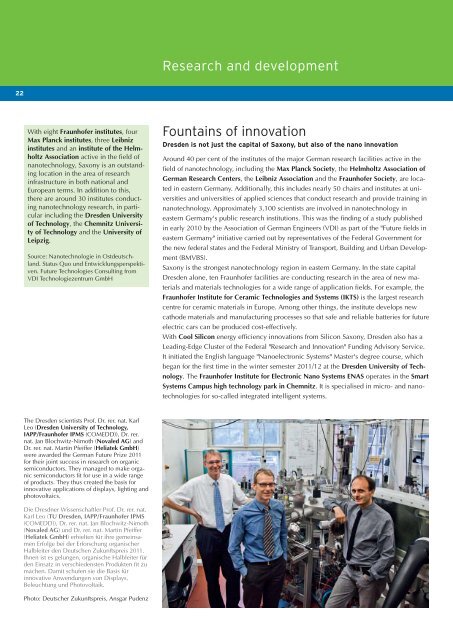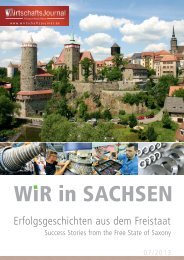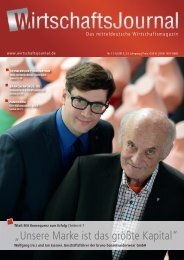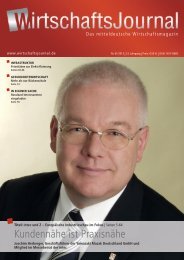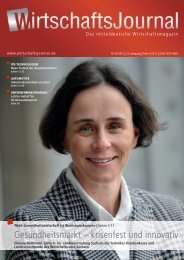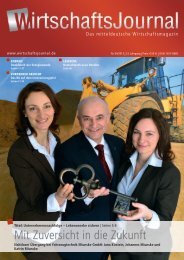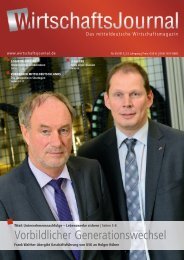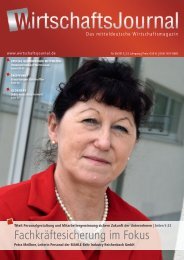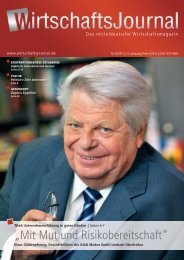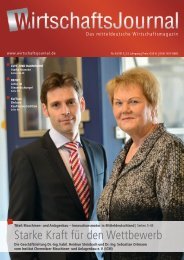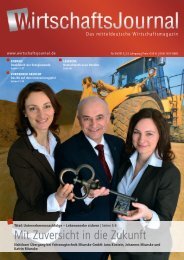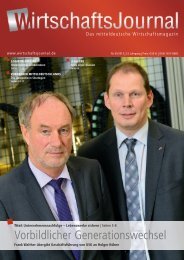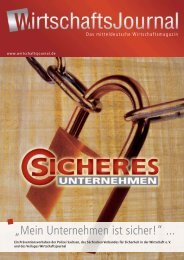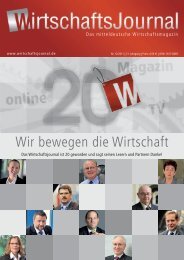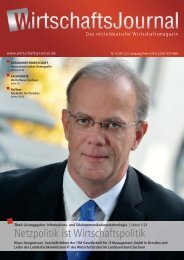Ausgabe 02/2012 - Wirtschaftsjournal
Ausgabe 02/2012 - Wirtschaftsjournal
Ausgabe 02/2012 - Wirtschaftsjournal
Erfolgreiche ePaper selbst erstellen
Machen Sie aus Ihren PDF Publikationen ein blätterbares Flipbook mit unserer einzigartigen Google optimierten e-Paper Software.
22<br />
With eight Fraunhofer institutes, four<br />
Max Planck institutes, three Leibniz<br />
institutes and an institute of the Helmholtz<br />
Association active in the field of<br />
nanotechnology, Saxony is an outstand -<br />
ing location in the area of research<br />
infrastructure in both national and<br />
European terms. In addition to this,<br />
there are around 30 institutes conduct -<br />
ing nanotechnology research, in particular<br />
including the Dresden University<br />
of Technology, the Chemnitz University<br />
of Technology and the University of<br />
Leipzig.<br />
Source: Nanotechnologie in Ostdeutschland.<br />
Status Quo und Entwicklungsperspektiven.<br />
Future Technologies Consulting from<br />
VDI Technologiezentrum GmbH<br />
The Dresden scientists Prof. Dr. rer. nat. Karl<br />
Leo (Dresden University of Technology,<br />
IAPP/Fraunhofer IPMS (COMEDD)), Dr. rer.<br />
nat. Jan Blochwitz-Nimoth (Novaled AG) and<br />
Dr. rer. nat. Martin Pfeiffer (Heliatek GmbH)<br />
were awarded the German Future Prize 2011<br />
for their joint success in research on organic<br />
semiconductors. They managed to make organic<br />
semiconductors fit for use in a wide range<br />
of products. They thus created the basis for<br />
innovative applications of displays, lighting and<br />
photovoltaics.<br />
Die Dresdner Wissenschaftler Prof. Dr. rer. nat.<br />
Karl Leo (TU Dresden, IAPP/Fraunhofer IPMS<br />
(COMEDD)), Dr. rer. nat. Jan Blochwitz-Nimoth<br />
(Novaled AG) und Dr. rer. nat. Martin Pfeiffer<br />
(Heliatek GmbH) erhielten für ihre gemeinsamen<br />
Erfolge bei der Erforschung organischer<br />
Halbleiter den Deutschen Zukunftspreis 2011.<br />
Ihnen ist es gelungen, organische Halbleiter für<br />
den Einsatz in verschiedensten Produkten fit zu<br />
machen. Damit schufen sie die Basis für<br />
innovative Anwendungen von Displays,<br />
Beleuchtung und Photovoltaik.<br />
Photo: Deutscher Zukunftspreis, Ansgar Pudenz<br />
Research and development<br />
Fountains of innovation<br />
Dresden is not just the capital of Saxony, but also of the nano innovation<br />
Around 40 per cent of the institutes of the major German research facilities active in the<br />
field of nanotechnology, including the Max Planck Society, the Helmholtz Association of<br />
German Research Centers, the Leibniz Association and the Fraunhofer Society, are located<br />
in eastern Germany. Additionally, this includes nearly 50 chairs and institutes at universities<br />
and universities of applied sciences that conduct research and provide training in<br />
nanotechnology. Approximately 3,100 scientists are involved in nanotechnology in<br />
eastern Germany's public research institutions. This was the finding of a study published<br />
in early 2010 by the Association of German Engineers (VDI) as part of the "Future fields in<br />
eastern Germany" initiative carried out by representatives of the Federal Government for<br />
the new federal states and the Federal Ministry of Transport, Building and Urban Development<br />
(BMVBS).<br />
Saxony is the strongest nanotechnology region in eastern Germany. In the state capital<br />
Dresden alone, ten Fraunhofer facilities are conducting research in the area of new ma -<br />
terials and materials technologies for a wide range of application fields. For example, the<br />
Fraunhofer Institute for Ceramic Technologies and Systems (IKTS) is the largest research<br />
centre for ceramic materials in Europe. Among other things, the institute develops new<br />
cathode materials and manufacturing processes so that safe and reliable batteries for future<br />
electric cars can be produced cost-effectively.<br />
With Cool Silicon energy efficiency innovations from Silicon Saxony, Dresden also has a<br />
Leading-Edge Cluster of the Federal "Research and Innovation" Funding Advisory Service.<br />
It initiated the English language "Nanoelectronic Systems" Master's degree course, which<br />
began for the first time in the winter semester 2011/12 at the Dresden University of Tech -<br />
nology. The Fraunhofer Institute for Electronic Nano Systems ENAS operates in the Smart<br />
Systems Campus high technology park in Chemnitz. It is specialised in micro- and nanotechnologies<br />
for so-called integrated intelligent systems.


